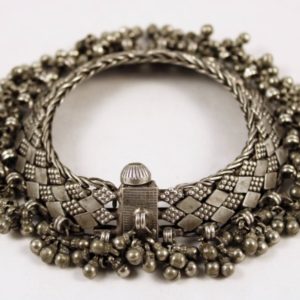-
Silver bazuband amulet from India, which is used tied on the forearm. It represents an unusual iconography from Hindu mythology. High-grade silver. From the 1st half of the 20th century. Dimensions:8 x 4,5 cm Weight: 20 gr IND1610
-
Silver flexible "paizebh" anklet from Uttar Pradesh, India. High-grade silver shaped in a beautiful chain. From mid-XXth Century or earlier. It can be opened easily with a pin. This kind of flexible Indian anklets look lighter and more frivolous than the rigid pieces that can be found in other regions in India, but they are usually heavier than they appear to be. Women in traditional Central India usually wear several flexible and rigid anklets on each leg at the same time. Check the post about Indian anklets here in my blog for more information. Dimensions: Length: 22,5 cm Width: 3,5 cm Weight: 134,1 gr. Literature: “De kracht van Zilver. Etnische sieraden uit de collectie smith hutschenruyter”, Mols, Luitgard, Wereld Museum, Rotterdam, 2011 “Indian Jewellery”, Holbein Hendley, Thomas, BR publication, Delhi, 2009 “Traditional jewelry of India”, Untracht, Oppi, Harry N. Abrams. Inc publishers, 1997 IND1570
-
Uzbek necklace, most probably from Bokhara (Central Asia). Made of silver, gilded silver, glass cabochons, coral, mother of pearl, pearls and some turquoises. First quarter of the 20th century. Provenance: Italian private collection. Dimensions: Length without cords: approx 60 cm Central pendant 14 x 7 cm Weight: 127,9 gr Literature: “Colliers ethniques d'Afrique d'Asie, d'Océanie et d'Amérique”, Leurquin, Anne, Skira, 2003, p. 198 “Il corallo. Nell'ornamento dell'Asia islamica dalla Turchia all'Uzbekistan”, del Mare, Cristina-Vidale, Massimo, Electa napoli, 2001 “Kyrgyzstan. Ethnic jewellery of Central Asia”, Kadyrov, V., Rarity Firm LTD, 2007, p.18 CA161
-
Big gilded silver amulet "Tumar", from Uzbekistan (Central Asia). Materials: silver, gilded silver, turquoisea and glass. From the 19th century or early 20th. Dimensions: 13 x 9,5 x 1,7 cm Weight: 156,8 gr Literature: “Il corallo. Nell'ornamento dell'Asia islamica dalla Turchia all'Uzbekistan”, del Mare, Cristina-Vidale, Massimo, Electa napoli, 2001, p. 101 “Museum of the ethnography of the peoples of the USSR”, Aurora Art Publishers, Leningrad, 1988, p. 118 “A song in metal. Folk Art of Uzbekistan”, Abdullayev, T, Gafur Gulyam Art and Literature Publishers, Tashkent, 1986, p. 237 “Traditional jewellery from Soviet Central Asia and Kazakhstan”, Sovetsky khudozhnik Publishers, 1984, 163 CA201
-
Old silver anklet from the Golden Triangle area in SE Asia. This type of anklets and bracelets can be massive or hollow, like this one. The two ends are stylized lotus buds. Very similar gold bracelets were worn in Bangkok in the XIXth Century. From the beginning of the XXth Century. Mainly worn by the Wa/Lawa people. The inside perimeter is approx. 21 cm (8,27 in) and the inner diameter is 7,3 cm (2,87 in) It weighs 50 gr. Bibliography: Anne van Cutsen book “A world of bracelets” Anne Richter book “The jewelry of Southeast Asia”. SEA290
-
High grade silver bracelet in spiral shape narrowing towards the end, used mainly by Wa/Lawa people, one of the Hill Tribes inhabiting the Golden Triangle (SE Asia). Age: First half of the 20th century Provenance: Italian private collection Dimensions: Inner diameter: 6 cm Width: 2 cm Weight: 75,5 gr Literature: “Peoples of the golden triangle”, Lewin, Paul and Elaine, River Books, Bangkok, 1998, p.42 “The art of silver jewellery. From the minorities of China, the Golden Triangle, Mongolia and Tibet”, Skira, 2006, p. 159 “Bracelets ethniques d'afrique, d'Asie d'Océanie et d'Amérique”, van Cutsem, Anne, Skira, 2002, p. 267 “Silver from fetish to fashion”, Nadler, Daniel and Serga, pdn publishing, 2005, p. 327 SEA495
-
Three wood and silver hair pins worn on the hair by the Tai Daeng people of Laos, the Muong people from Vietnam and Mon-Khmer speaking minorities in nothern Vietnam. The top of all three have a lid that was used to store the tobacco or small objects and amulets, although in this case they are too worn and the lids cannot be opened easily. Made of wood and high grade silver. From the 19th century or early 20th. Provenance: Italian private collection. Dimensions: 27 x 3 x 2 cm Literature: “Parures ethniques. Le culte de la beauté”, Geoffroy-Schneiter, Bérénice, Assouline, Paris, 2001, p. 184 “The jewelry of Southeast Asia”, Richter, Anne, Thames & Hudson, 2000, p. 138 “The art of silver jewellery”, Skira, 2006, p. 152 “Ethnic jewellery and adornment” Daalder, Truus, Ethnic Art Press, 2009, p. 231 SEA468-70
-
Black Yao back adornment, from different subgroups like the Iu Mien, inhabiting Laos and Thailand. It is made with long cotton streamers which hang on the back of the tunic collars. The top is made with enamel medals (both sides), silver bells and glass beads. Traditionally this dark burgundy red is used. The most recent ones used a much brighter red. From the 1st half of 20th century. Dimensions: Length: 65 cm Width on top (with beads): 9 cm Reference: “The Yao” Pourret, Jess G.,River Books, Bangkok, 2002 SEA226
-
Vintage Zuni silver and turquoise bracelet, from the Zuni people inhabiting New México (USA). Age:20th century Made of high grade silver and turquoise. Dimensions: Total size: 7 x 5,8 x 2 cm Inner size: 6,3 cm Weight: 56,9 gr Literature: “Bracelets ethniques d'afrique, d'Asie d'Océanie et d'Amérique”, van Cutsem, Anne, Skira, 2002, p. 321 “Indian silver jewelry of the Southwest 1868-1930”, Frank. Larry, Schiffer, 1990 “Turquoise”, Mark P. Block, Schiffer, 2017 “North American Indian jewelry and adornment”, Sherr Dubin, Lois, Harry N. Abrams, 1999 AME13









